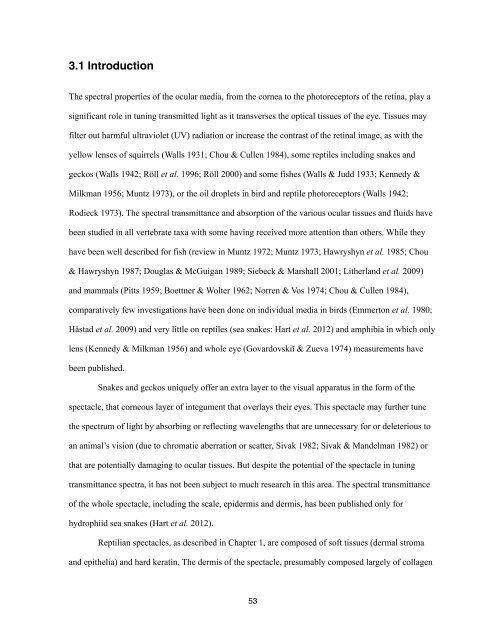Chapter 1, The Reptilian Spectacle - UWSpace - University of ...
Chapter 1, The Reptilian Spectacle - UWSpace - University of ...
Chapter 1, The Reptilian Spectacle - UWSpace - University of ...
Create successful ePaper yourself
Turn your PDF publications into a flip-book with our unique Google optimized e-Paper software.
3.1 Introduction<br />
<strong>The</strong> spectral properties <strong>of</strong> the ocular media, from the cornea to the photoreceptors <strong>of</strong> the retina, play a<br />
significant role in tuning transmitted light as it transverses the optical tissues <strong>of</strong> the eye. Tissues may<br />
filter out harmful ultraviolet (UV) radiation or increase the contrast <strong>of</strong> the retinal image, as with the<br />
yellow lenses <strong>of</strong> squirrels (Walls 1931; Chou & Cullen 1984), some reptiles including snakes and<br />
geckos (Walls 1942; Röll et al. 1996; Röll 2000) and some fishes (Walls & Judd 1933; Kennedy &<br />
Milkman 1956; Muntz 1973), or the oil droplets in bird and reptile photoreceptors (Walls 1942;<br />
Rodieck 1973). <strong>The</strong> spectral transmittance and absorption <strong>of</strong> the various ocular tissues and fluids have<br />
been studied in all vertebrate taxa with some having received more attention than others. While they<br />
have been well described for fish (review in Muntz 1972; Muntz 1973; Hawryshyn et al. 1985; Chou<br />
& Hawryshyn 1987; Douglas & McGuigan 1989; Siebeck & Marshall 2001; Litherland et al. 2009)<br />
and mammals (Pitts 1959; Boettner & Wolter 1962; Norren & Vos 1974; Chou & Cullen 1984),<br />
comparatively few investigations have been done on individual media in birds (Emmerton et al. 1980;<br />
Håstad et al. 2009) and very little on reptiles (sea snakes: Hart et al. 2012) and amphibia in which only<br />
lens (Kennedy & Milkman 1956) and whole eye (Govardovskiĭ & Zueva 1974) measurements have<br />
been published.<br />
Snakes and geckos uniquely <strong>of</strong>fer an extra layer to the visual apparatus in the form <strong>of</strong> the<br />
spectacle, that corneous layer <strong>of</strong> integument that overlays their eyes. This spectacle may further tune<br />
the spectrum <strong>of</strong> light by absorbing or reflecting wavelengths that are unnecessary for or deleterious to<br />
an animal’s vision (due to chromatic aberration or scatter, Sivak 1982; Sivak & Mandelman 1982) or<br />
that are potentially damaging to ocular tissues. But despite the potential <strong>of</strong> the spectacle in tuning<br />
transmittance spectra, it has not been subject to much research in this area. <strong>The</strong> spectral transmittance<br />
<strong>of</strong> the whole spectacle, including the scale, epidermis and dermis, has been published only for<br />
hydrophiid sea snakes (Hart et al. 2012).<br />
<strong>Reptilian</strong> spectacles, as described in <strong>Chapter</strong> 1, are composed <strong>of</strong> s<strong>of</strong>t tissues (dermal stroma<br />
and epithelia) and hard keratin. <strong>The</strong> dermis <strong>of</strong> the spectacle, presumably composed largely <strong>of</strong> collagen<br />
53
















